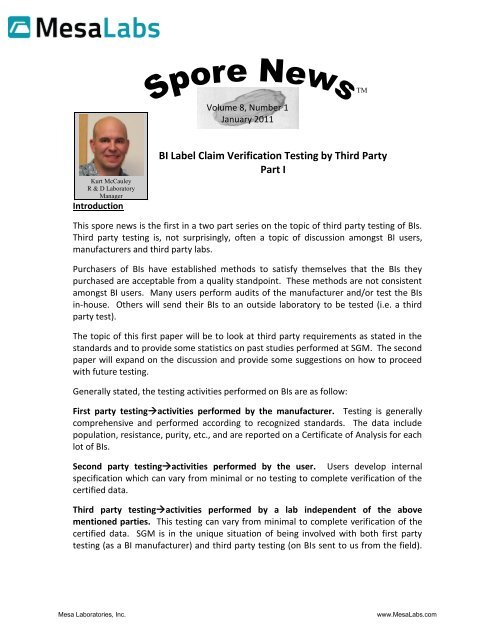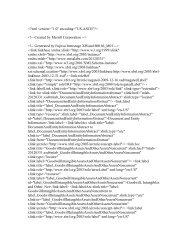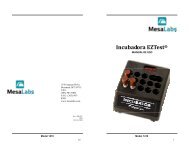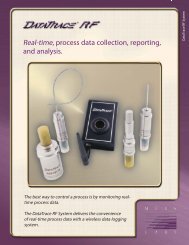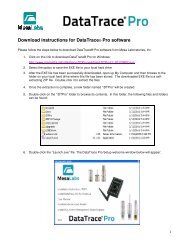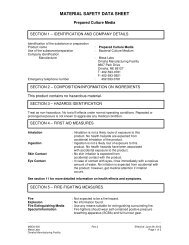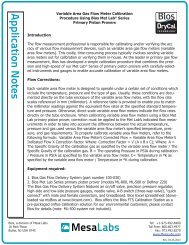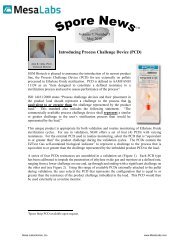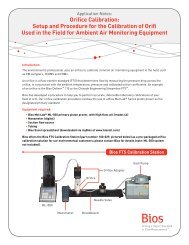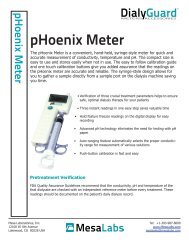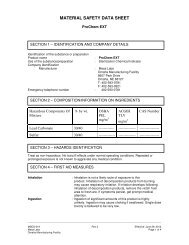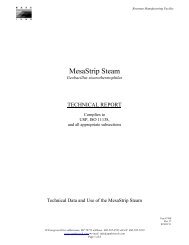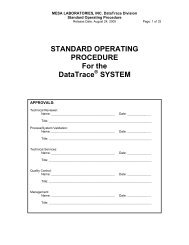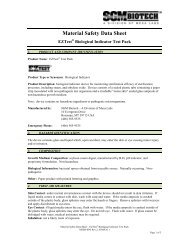Part 1 - Mesa Labs
Part 1 - Mesa Labs
Part 1 - Mesa Labs
Create successful ePaper yourself
Turn your PDF publications into a flip-book with our unique Google optimized e-Paper software.
BIOLOGICAL INDICATOR SPECIALISTS<br />
TM<br />
Volume 8, Number 1<br />
January 2011<br />
Kurt McCauley<br />
R & D Laboratory<br />
Manager<br />
Introduction<br />
BI Label Claim Verification Testing by Third <strong>Part</strong>y<br />
<strong>Part</strong> I<br />
This spore news is the first in a two part series on the topic of third party testing of BIs.<br />
Third party testing is, not surprisingly, often a topic of discussion amongst BI users,<br />
manufacturers and third party labs.<br />
Purchasers of BIs have established methods to satisfy themselves that the BIs they<br />
purchased are acceptable from a quality standpoint. These methods are not consistent<br />
amongst BI users. Many users perform audits of the manufacturer and/or test the BIs<br />
in-house. Others will send their BIs to an outside laboratory to be tested (i.e. a third<br />
party test).<br />
The topic of this first paper will be to look at third party requirements as stated in the<br />
standards and to provide some statistics on past studies performed at SGM. The second<br />
paper will expand on the discussion and provide some suggestions on how to proceed<br />
with future testing.<br />
Generally stated, the testing activities performed on BIs are as follow:<br />
First party testingactivities performed by the manufacturer. Testing is generally<br />
comprehensive and performed according to recognized standards. The data include<br />
population, resistance, purity, etc., and are reported on a Certificate of Analysis for each<br />
lot of BIs.<br />
Second party testingactivities performed by the user. Users develop internal<br />
specification which can vary from minimal or no testing to complete verification of the<br />
certified data.<br />
Third party testingactivities performed by a lab independent of the above<br />
mentioned parties. This testing can vary from minimal to complete verification of the<br />
certified data. SGM is in the unique situation of being involved with both first party<br />
testing (as a BI manufacturer) and third party testing (on BIs sent to us from the field).<br />
<strong>Mesa</strong> Laboratories, Inc.<br />
www.<strong>Mesa</strong><strong>Labs</strong>.com
Additionally, we perform second party testing on BIs used in special studies. The first<br />
party testing is performed by the Production Laboratory and the second and third party<br />
testing is performed by the Contract Studies Laboratory.<br />
History<br />
A retrospective analysis of the data generated over the past six years (2005 – 2010) was<br />
performed. There were exactly 100 studies performed in that time period. The studies<br />
were performed upon request for 21 unique BI users and using product from eight<br />
unique BI manufacturers. Most of the BIs were commercially prepared, but a few were<br />
custom made biological indicators.<br />
The BI configurations included spore strips (56 studies), self-contained (3 studies),<br />
liquid-submersible ampoule (9 studies), suspension (19 studies), thread (9 studies) and<br />
wire (4 studies). Testing ranged from the basic (purity and population tests) to more all<br />
encompassing tests including D-value and survival/kill testing. Population verification<br />
was the test most commonly performed followed by D-value studies, survival/kill<br />
studies and finally combined D-value-survival/kill studies. In both the population<br />
verification and the survival/kill studies, over 90% of the label claims were confirmed. In<br />
the D-value verification studies, approximately 70% of the label claims were confirmed.<br />
See Table 1 for a complete summary.<br />
Purity and identification of test organism are not a common request and will not be<br />
discussed in any great detail. BI manufacturers generally identify the organism<br />
biochemically, genetically or using commercially prepared automated systems and will<br />
readily supply this information to the user upon request. Caution should be taken by<br />
second and third party labs using certain systems not well suited for identifying the type<br />
of organisms typically used in BIs.<br />
Table 1. Summary of the types and number of third party tests performed at SGM from<br />
2005 through 2010<br />
Study type <br />
Both D-value*<br />
Population D- Survival &<br />
and Survival &<br />
only value* Kill<br />
Kill<br />
Number of studies<br />
performed<br />
45 36 15 4<br />
% of studies confirming<br />
certified claims<br />
91.1% 69.4% 93.3% 75.0%<br />
*population verifications are a component of D-value studies<br />
Note: The acceptance criteria used in these studies was based on those stated<br />
in the standards. We will discuss this in greater detail in <strong>Part</strong> II of this<br />
Spore News.<br />
<strong>Mesa</strong> Laboratories, Inc.<br />
www.<strong>Mesa</strong><strong>Labs</strong>.com
ISO 14161 Standard<br />
ISO 14161, the guidance document for BI users, states that users “should have a system<br />
in place to provide assurance that the biological indicators obtained consistently meet<br />
the specified characteristics.” This is accomplished by obtaining “information from the<br />
manufacturer covering the performance characteristics of the lot of biological<br />
indicators…” (i.e. a Certificate of Analysis) or by performing “various degrees of testing<br />
on each lot of biological indicators...”<br />
Once a user “has established a high level of confidence in the supplier, the testing<br />
performed by the user may be minimal.” If the user deems testing necessary, then the<br />
performance of a population assay and survival-kill resistance testing should be<br />
considered. If the BI manufacturer produces product according to ISO 11138, (or other<br />
detailed standard specifications), then “testing of the resistance characteristics by the<br />
user is considered unnecessary.”<br />
USP<br />
Section of the USP (Biological Indicators for Sterilization / General Information)<br />
discusses “User’s Responsibilities”. Much of these recommendations are much the<br />
same as those stated in ISO. Summarizing a few points from USP: The BI user should,<br />
a) Establish in-house acceptance standards.<br />
b) Obtain a “Certificate of Performance” on each lot.<br />
c) Routinely perform audits of the manufacturer’s facilities and procedures.<br />
d) Verify purity and morphology of the BI microorganism.<br />
e) Verify microbial count.<br />
f) Observe and note manufacturer’s comments relative to D-value, storage<br />
conditions expiration dating, and stability (users may consider conducting a<br />
D-value assessment).<br />
Discussion<br />
As the standards imply, it is critical for a BI user to trust the performance of the BIs in<br />
hand. The best method to gain confidence in the BI is to gain confidence in the BI<br />
manufacturer. The least costly way to do this is to perform periodic quality audits of the<br />
BI manufacturer. The performance of the BI should be trusted if the BI manufacturer<br />
can demonstrate that it: 1) is a quality operation; 2) possesses the specialized<br />
equipment necessary to perform such tests; 3) employs knowledgeable and trained<br />
personnel; and 4) manufactures BIs according to recognized standards. Once<br />
demonstrated, it is acceptable for the user to accept the data presented on the<br />
Certificate of Analysis with confidence. The population assay is one relatively simple<br />
test the user should consider performing when accepting a lot of BIs. Because the BI<br />
units must travel from the manufacturer to the user, this test will ensure that the BIs<br />
arrived in good working condition.<br />
<strong>Mesa</strong> Laboratories, Inc.<br />
www.<strong>Mesa</strong><strong>Labs</strong>.com
Performing quality audits are costly, but not as costly as performing extensive testing on<br />
each lot of BIs. Additionally, many lots of BIs will be rejected by second and third party<br />
testing, not because of a BI defect, but because of differences in test equipment and<br />
techniques. Many papers have been written on this topic and we will discuss this<br />
further in <strong>Part</strong> II of this Spore News.<br />
BI users must determine internally the level of testing to be performed on each lot of BIs<br />
received. The testing can be done in-house or by a third party. Figure 1 is a simple<br />
diagram that illustrates the effort level required for each type of verification study.<br />
Accept certified values (must first gain trust of manufacturer<br />
through audits, verification studies, etc.)<br />
Population verification (minimal equipment needed, but<br />
moderate training required)<br />
Survival/Kill verification (specialized equipment<br />
required with a higher level of training)<br />
D-value verification (specialized equipment<br />
required with a higher level of training)<br />
Easy<br />
Difficult<br />
Figure 1. Level of effort required by users when accepting a lot of biological indicators.<br />
In the second paper on the third party testing topic, we intend to discuss acceptance<br />
criteria, methods of resistance determination (manufacturer vs. user), resistometer<br />
types and performance, and BI types.<br />
SPORES DON’T LIE ®<br />
Please email us with topics you would like to see addressed in “Spore News”.<br />
<strong>Mesa</strong> Laboratories, Inc.<br />
www.<strong>Mesa</strong><strong>Labs</strong>.com


